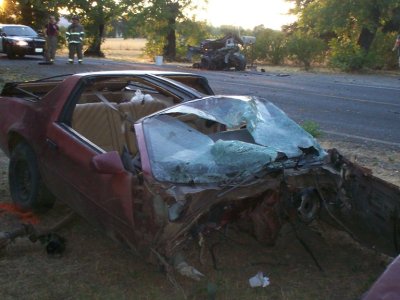- Elizabeth Larson
- Posted On
CHP responds to collisions around county Friday
California Highway Patrol Officer Josh Dye said the day started off when a delivery truck driver traveling southbound on Highway 29 north of Highway 53 went off the road and collided with a Pacific Gas & Electric pole at 6:20 a.m.
Dye said the driver was flown to Santa Rosa Memorial Hospital. The CHP incident log noted the driver had major injuries.
The delivery truck, still at the scene mid-morning, was sheered almost in half lengthwise.
The collision knocked down the power lines, said Dye. PG&E spent the morning repairing the lines and installing a new pole, which made it necessary to close the northbound lane for four hours.
Traffic at 10:30 a.m. was backed up for several miles while Caltrans and CHP helped direct traffic to move around the repair area.
Another accident involving a pear truck and a car occurred at 11:18 a.m., said Dye,which blocked both lanes of Highway 29 and Highway 281 at Kit's Corner.
Dye said the collision involved David Williams, 45, of Sacramento who was driving a Peterbilt pear truck southbound on Highway 29 and Sabina Gotuacd, 46, of Daly City, driving a Toyota Corolla.
Gotuacd was stopped at Highway 281 to turn southbound onto Highway 29. Dye said she pulled out directly in front of the truck driven by Williams, who veered to avoid hitting her but couldn't avoid a collision.
The right front passenger in Gotuacd's car, a female juvenile, was flown to Santa Rosa Memorial Hospital as a precautionary measure, said Dye.
He added that officers at the scene said Williams' quick thinking prevented the collision from being much worse.
Another collision was reported on Elk Mountain Road in Upper Lake at 1:03 p.m., but Dye said all the parties involved had left the scene by the time CHP officers arrived.
From there officers responded at 1:26 p.m. to a two-vehicle collision on Highway 20 west of Clearlake Oaks, said Dye.
On the way to that crash, CHP Officer Carl Thompson was involved in a three-car collision, said Dye.
Jack Barnes, 53, of Windsor was driving a 2006 BMW westbound and saw Thompson approaching, so he yielded onto the right shoulder, said Dye.
Jodi Gorden, 21, of Red Bluff was driving behind Barnes in a 1994 Ford Escort, and didn't immediately see Barnes yield, said Dye. Gorden locked up her brakes and swerved to the left to avoid the BMW, but collided with left rear of Barnes' car and glanced off further to the left.
Thompson, who was preparing to pass the vehicles at the time, saw the crash and came to a near stop before the left side of his patrol vehicle was hit by Gorden at a low speed, according to Dye's report.
No one was injured and the vehicles were moved off to the right road shoulder to keep traffic moving, Dye added.
Officer Craig Van Housen, who also was headed to the Clearlake Oaks collision, continued on as Thompson dealt with his crash, said Dye.
Arriving at the accident scene, Van Housen found two vehicles blocking the road lanes with no injuries, Dye reported. Involved were Mary Johnson, 65, of Sacramento who was driving a 1998 Dodge Van and Timothy Rice, 20, of Marysville driving a 1997 Honda Civic.
Dye said the collision was minor and no one was transported to the hospital.
Then, just after 5 p.m., another collision occurred on eastbound Highway 20 at Pyle Road in Nice.
The CHP reported no injuries in that crash, which involved a gray truck versus a light blue sedan. Officials were still cleaning up at the scene after 6 p.m.
Just after 7 p.m., a vehicle was reported on fire on westbound Highway 20 at Walker Ridge Road near the Lake/Colusa County lines. The CHP reported the driver was trying to extinguish the fire, which started under the car and worked up to under the hood.
After 10 p.m. there were two other reports of collisions without injuries, one involving a single vehicle on Point Lakeview near Jago Bay, and another in an unspecified area of Lake County. No additional information was available on either incident.
E-mail Elizabeth Larson at This email address is being protected from spambots. You need JavaScript enabled to view it..
{mos_sb_discuss:2}








